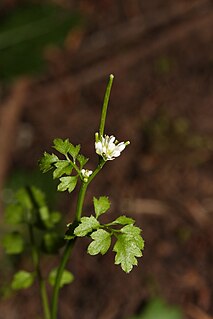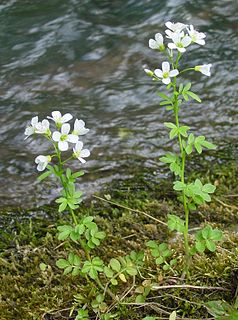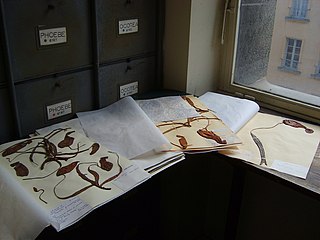
Brassicaceae or Cruciferae is a medium-sized and economically important family of flowering plants commonly known as the mustards, the crucifers, or the cabbage family. Most are herbaceous plants, some shrubs, with simple, although sometimes deeply incised, alternatingly set leaves without stipules or in leaf rosettes, with terminal inflorescences without bracts, containing flowers with four free sepals, four free alternating petals, two short and four longer free stamens, and a fruit with seeds in rows, divided by a thin wall.

Nasturtium is a genus of seven plant species in the family Brassicaceae, best known for the edible watercresses Nasturtium microphyllum and Nasturtium officinale. Nasturtium was previously synonymised with Rorippa, but molecular evidence supports its maintenance as a distinct genus more closely related to Cardamine than to Rorippasensu stricto. Watercress or yellowcress is a common name for plants in this genus.

Cardamine is a large genus of flowering plants in the mustard family, Brassicaceae, known as bittercresses and toothworts. It contains more than 200 species of annuals and perennials. Species in this genus can be found worldwide, except the Antarctic, in diverse habitats. The name Cardamine is derived from the Greek kardamon, cardamom, an unrelated plant in the ginger family, used as a pungent spice in cooking.

Arabis, or rockcress, is a genus of flowering plants, within the family Brassicaceae, subfamily Brassicoideae.

Cardamine pratensis, is a flowering plant in the family Brassicaceae, native throughout most of Europe and Western Asia. The specific name pratensis is Latin for "meadow."

Cardamine hirsuta, commonly called hairy bittercress, is an annual or biennial member of the mustard family (Brassicaceae), and is edible as a bitter herb. It is common in moist areas around the world.

Cardamine impatiens, the narrowleaf bittercress or narrow-leaved bitter-cress, is a plant species of the genus Cardamine belonging to the family Brassicaceae. It is a slender, biennial herb, that produces sterile leaves in the first year, one to several flowering stems during the next. Its leaves are pinnate with several pairs of lanceolate, dentate leaflets and a terminal, slightly longer leaflet. The short petals surpass the calyx by half of its length. The seeds are arranged in one row on each side of the central membrane of the narrow pod and are ejected out in a shower due to the tension formed as the seed pod (silique) dries. It grows on walls, open ground in shady places in forests usually disturbed by man.

Peltaria is a genus of flowering plants, within the family Brassicaceae. Their distribution ranges from Southeast Europe, Near East to Central Asia. They prefer rocky slopes.

Peltaria alliacea is a perennial in the family Brassicaceae, endemic in Southeastern Europe. The plant grows up to 60 cm (24 in) and flowers white from May to July. The plant is glabrous (hairless) with simple, entire leaves. The leaves are ovate, sessile and amplexicaule. When crushed they smell of garlic, hence the common name. The 3–4 mm (0.12–0.16 in) long white petals are shortly clawed. The orbicular, very flat silicula or seed, is pendent and has a size of about 6 by 6 mm. Its chromosome number is 2n=14.
Ihsan Ali Al-Shehbaz, Ph.D. is an Iraqi American botanist who works as Adjunct Professor at University of Missouri-St. Louis and Senior Curator at Missouri Botanical Garden. Al-Shehbaz's primary area of interest is Brassicaceae and The Durango Herald called him "a world expert on taxonomy of the family". A 2008 publication of the United States Fish and Wildlife Service called him "the world's authority on species in the genus Lesquerella". The author abbreviation "Al-Shehbaz" is attached to the numerous botanical taxa he has identified.

Cardamine corymbosa, commonly known as the New Zealand bitter-cress, is a flowering plant in the cabbage family, Brassicaceae. Native to the subantarctic islands of Australasia, it has become an invasive species in plant nurseries. The specific epithet refers to the structure of the inflorescence.
Petroravenia eseptata is a plant species native to Argentina. It is also type species for its genus, Petroravenia, first described in 1994.
Pegaeophyton nepalense is a plant species reported from Nepal, Bhutan, Sikkim and Xizang. It is found high in the Himalayas at elevations of over 4000 m.
Arabidopsis arenicola, the Arctic rock-cress, is a plant species native to the northeastern part of North America. It has been reported from Greenland, Labrador, Nunavut, Northwest Territories, Québec, Ontario, Manitoba, and Saskatchewan. It grows on sandy or gravely beaches or stream banks at elevations below 1,500 metres (4,900 ft).
Braya thorild-wulffii, the Greenland northern rockcress, is a plant species native to Greenland, Nunavut the Canadian Northwest Territories, and from the Chukotka Autonomous Okrug of eastern Russia.
Tropidocarpum californicum, the king's gold, is a plant species endemic to a small region in California. It is known from only Kern and King counties in the southern part of the San Joaquin Valley.

Cardamine amara, known as large bitter-cress, is a species of flowering plant in the family Brassicaceae. It is a perennial with upright, mostly unbranched, stems to 70 cm (28 in) tall, and leaves made up of between three and 13 leaflets. The flowers have petals that are 8–14 mm (0.3–0.6 in) long and are generally white, although sometimes pink or purple. It is found in damp places.

Lepidium heterophyllum,, is a species of flowering plant in the mustard family which is native to parts of western Europe, growing in shingle banks, wasteland or cultivated fields.

Cardamine heptaphylla, common name pinnate coralroot is a species of flowering plants in the family Brassicaceae.
















